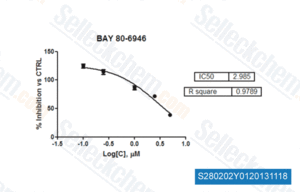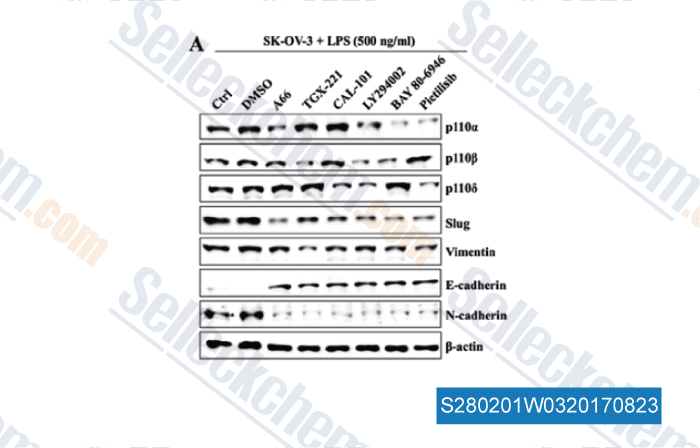|
Toll Free: (877) 796-6397 -- USA and Canada only -- |
Fax: +1-832-582-8590 Orders: +1-832-582-8158 |
Tech Support: +1-832-582-8158 Ext:3 Please provide your Order Number in the email. |
Technical Data
| Formula | C23H28N8O4 |
|||
| Molecular Weight | 480.52 | CAS No. | 1032568-63-0 | |
| Solubility (25°C)* | In vitro | DMSO | Insoluble | |
| Water | Insoluble | |||
| Ethanol | Insoluble | |||
|
* <1 mg/ml means slightly soluble or insoluble. * Please note that Selleck tests the solubility of all compounds in-house, and the actual solubility may differ slightly from published values. This is normal and is due to slight batch-to-batch variations. * Room temperature shipping (Stability testing shows this product can be shipped without any cooling measures.) |
||||
Preparing Stock Solutions
Biological Activity
| Description | Copanlisib is a potent pan-class I PI3K with IC50 of 0.5, 3.7, 6.4, and 0.7 nM in cell-free assays for PI3Kα/β/γ/δ , respectively. Phase 3.This product has poor solubility, animal experiments are available, cell experiments please choose carefully! | ||||||||
|---|---|---|---|---|---|---|---|---|---|
| Targets |
|
||||||||
| In vitro | In both KPL4 cells and LPA-stimulated PC3 cells, BAY 80-6946 reduces pAKT levels. In a subset of human cancer cell lines with PIK3CA mutations and/or overexpression of HER2, BAY 80-6946 shows antiproliferative activity and induces apoptosis. [1] The combination of HER2-targeted therapies and BAY 80-6946 inhibits growth more effectively than either therapy used alone, and can restore sensitivity to trastuzumab and lapatinib in cells. [2] |
||||||||
| In vivo | In rat KPL4 or HCT116 tumor xenograft model, BAY 80-6946 (6 mg/kg, i.v.) induces 100% complete tumor regression. In nude mice with Lu7860 erlotinib-resistant, patient-derived NSCLC and MAXF1398 patient-derived luminal breast tumor models, BAY 80-6946 (14 mg/kg, i.v.) also causes tumor growth inhibition. [1] |
Protocol (from reference)
| Kinase Assay: |
|
|---|---|
| Cell Assay: |
|
| Animal Study: |
|
References
|
Customer Product Validation

-
, , Dr. Antonino Maria Spartà from University of Bolog

-
, , Dr. Antonino Maria Spartà from University of Bolog

-
Data from [Data independently produced by , , Oncol Rep, 2017, 37(5):3137-3145]
Selleck's Copanlisib has been cited by 49 publications
| UHRF1 is a mediator of KRAS driven oncogenesis in lung adenocarcinoma [ Nat Commun, 2023, 14(1):3966] | PubMed: 37407562 |
| Leveraging molecular structure and bioactivity with chemical language models for de novo drug design [ Nat Commun, 2023, 14(1):114] | PubMed: 36611029 |
| Single-cell dissection of Merkel cell carcinoma heterogeneity unveils transcriptomic plasticity and therapeutic vulnerabilities [ Cell Rep Med, 2023, 4(7):101101] | PubMed: 37421947 |
| Subtype-selective induction of apoptosis in translocation-related sarcoma cells induced by PUMA and BIM upon treatment with pan-PI3K inhibitors [ Cell Death Dis, 2023, 14(2):169] | PubMed: 36849535 |
| Protein Tyrosine Phosphatase Non-Receptor 11 (PTPN11/Shp2) as a Driver Oncogene and a Novel Therapeutic Target in Non-Small Cell Lung Cancer (NSCLC) [ Int J Mol Sci, 2023, 24(13)10545] | PubMed: 37445722 |
| Protein Tyrosine Phosphatase Non-Receptor 11 (PTPN11/Shp2) as a Driver Oncogene and a Novel Therapeutic Target in Non-Small Cell Lung Cancer (NSCLC) [ Int J Mol Sci, 2023, 24(13)10545] | PubMed: 37445722 |
| Targeting IRAK4 with Emavusertib in Lymphoma Models with Secondary Resistance to PI3K and BTK Inhibitors [ J Clin Med, 2023, 12(2)399] | PubMed: 36675328 |
| Suppression of tumor cell lactate-generating signaling pathways eradicates murine PTEN/p53-deficient aggressive-variant prostate cancer via macrophage phagocytosis [ bioRxiv, 2023, 2023.05.23.540590] | PubMed: 37292972 |
| Triple MAPK inhibition salvaged a relapsed post-BCMA CAR-T cell therapy multiple myeloma patient with a BRAF V600E subclonal mutation [ J Hematol Oncol, 2022, 15(1):109] | PubMed: 35978321 |
| Lysosomal targetomics of ghr KO mice shows chaperone-mediated autophagy degrades nucleocytosolic acetyl-coA enzymes [ Autophagy, 2022, 18(7):1551-1571] | PubMed: 34704522 |
RETURN POLICY
Selleck Chemical’s Unconditional Return Policy ensures a smooth online shopping experience for our customers. If you are in any way unsatisfied with your purchase, you may return any item(s) within 7 days of receiving it. In the event of product quality issues, either protocol related or product related problems, you may return any item(s) within 365 days from the original purchase date. Please follow the instructions below when returning products.
SHIPPING AND STORAGE
Selleck products are transported at room temperature. If you receive the product at room temperature, please rest assured, the Selleck Quality Inspection Department has conducted experiments to verify that the normal temperature placement of one month will not affect the biological activity of powder products. After collecting, please store the product according to the requirements described in the datasheet. Most Selleck products are stable under the recommended conditions.
NOT FOR HUMAN, VETERINARY DIAGNOSTIC OR THERAPEUTIC USE.
